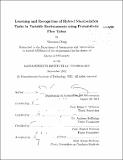Learning and recognition of hybrid manipulation tasks in variable environments using probabilistic flow tubes
Author(s)
Dong, Shuonan
DownloadFull printable version (16.82Mb)
Other Contributors
Massachusetts Institute of Technology. Dept. of Aeronautics and Astronautics.
Advisor
Brian C. Williams.
Terms of use
Metadata
Show full item recordAbstract
Robots can act as proxies for human operators in environments where a human operator is not present or cannot directly perform a task, such as in dangerous or remote situations. Teleoperation is a common interface for controlling robots that are designed to be human proxies. Unfortunately, teleoperation may fail to preserve the natural fluidity of human motions due to interface limitations such as communication delays, non-immersive sensing, and controller uncertainty. I envision a robot that can learn a set of motions that a teleoperator commonly performs, so that it can autonomously execute routine tasks or recognize a user's motion in real time. Tasks can be either primitive activities or compound plans. During online operation, the robot can recognize a user's teleoperated motions on the fly and offer real-time assistance, for example, by autonomously executing the remainder of the task. I realize this vision by addressing three main problems: (1) learning primitive activities by identifying significant features of the example motions and generalizing the behaviors from user demonstration trajectories; (2) recognizing activities in real time by determining the likelihood that a user is currently executing one of several learned activities; and (3) learning complex plans by generalizing a sequence of activities, through auto-segmentation and incremental learning of previously unknown activities. To solve these problems, I first present an approach to learning activities from human demonstration that (1) provides flexibility and robustness when encoding a user's demonstrated motions by using a novel representation called a probabilistic flow tube, and (2) automatically determines the relevant features of a motion so that they can be preserved during autonomous execution in new situations. I next introduce an approach to real-time motion recognition that (1) uses temporal information to successfully model motions that may be non-Markovian, (2) provides fast real-time recognition of motions in progress by using an incremental temporal alignment approach, and (3) leverages the probabilistic flow tube representation to ensure robustness during recognition against varying environment states. Finally, I develop an approach to learn combinations of activities that (1) automatically determines where activities should be segmented in a sequence and (2) learns previously unknown activities on the fly. I demonstrate the results of autonomously executing motions learned by my approach on two different robotic platforms supporting user-teleoperated manipulation tasks in a variety of environments. I also present the results of real-time recognition in different scenarios, including a robotic hardware platform. Systematic testing in a two-dimensional environment shows up to a 27% improvement in activity recognition rates over prior art, while maintaining average computing times for incremental recognition of less than half of human reaction time.
Description
Thesis (Ph. D.)--Massachusetts Institute of Technology, Dept. of Aeronautics and Astronautics, 2012. This thesis was scanned as part of an electronic thesis pilot project. Cataloged from PDF version of thesis. This thesis was scanned as part of an electronic thesis pilot project. Includes bibliographical references (p. 139-144).
Date issued
2012Department
Massachusetts Institute of Technology. Department of Aeronautics and AstronauticsPublisher
Massachusetts Institute of Technology
Keywords
Aeronautics and Astronautics.